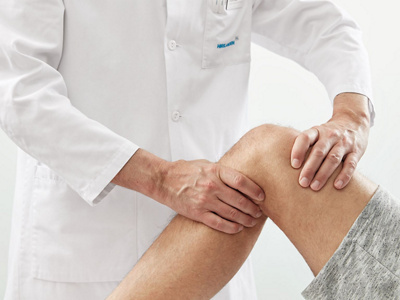An anterior cruciate ligament (ACL) tear is one of the most common and serious types of knee injuries. This injury is usually caused by a combination of the knee twisting and buckling under great force. A tear in the ACL can lead to instability in the knee and usually requires a long recovery time and possibly surgery to restore the full function of the knee joint.
Overview of the cruciate ligament
The knee joint is stabilised by four main ligaments: the anterior and posterior cruciate ligaments and the medial and lateral collateral ligaments. The anterior and posterior cruciate ligaments run inside the knee joint and cross over each other, which gives them a crucial stabilising function. The anterior cruciate ligament (ACL) prevents the lower leg from sliding forwards, while the posterior cruciate ligament (PCL) stops it from sliding backwards. A torn cruciate ligament, especially a tear in the anterior cruciate ligament, results in severe instability of the knee joint.
Cruciate ligament ruptures can often be accompanied by associated injuries such as meniscus tears, cartilage damage or medial collateral ligament injuries.
Causes and risk factors
High-energy impact to the knee, such as twisting, buckling or overstretching, can lead to a tear in the cruciate ligaments. The posterior cruciate ligament tears much less frequently than the anterior cruciate ligament, as the posterior cruciate ligament is much stronger and most trauma tends to affect the anterior cruciate ligament. A rupture of both the posterior and anterior cruciate ligaments at the same time is rare and only occurs in cases of very severe trauma.
Typically, anterior cruciate ligament tears occur during sporting activities that require rapid changes of direction, abrupt stopping, jumping and landing, and physical contact. These include football, basketball, skiing, handball and American football.
In addition to excessive pressure put on the knee joints during sport, there are other risk factors associated with ACL injuries:
Gender
Women have a higher risk of ACL tears than men, a fact that is attributed to anatomical divergences and differences in muscle strength and coordination.
Previous knee injuries
People who have already had a knee injury, especially a previous ACL tear, have a higher risk of tearing the ACL again.
Age
Owing to age-related changes in the body, such as a decrease in muscle strength, flexibility and general stability of the knee joint, older adults have an increased risk of ACL ruptures.
Fitness and muscle strength
Insufficient muscle strength, especially in the thigh muscles, and a lack of general physical fitness can increase the risk of an ACL tear.
Biomechanical factors
Certain movement patterns and postures, such as turning the knee inwards when landing or braking with an outstretched leg, can increase the risk of an ACL rupture.
Partial tear of the anterior cruciate ligament
A partial tear of the anterior cruciate ligament occurs when only part of the fibres of the anterior cruciate ligament are severed. This injury can affect the stability of the knee joint, but is often less serious than a complete tear. If the main part of the cruciate ligament remains intact and the fibres are not completely separated from each other, there is a possibility that a torn cruciate ligament can heal by itself.
Complete tear of the anterior cruciate ligament
In the case of a complete tear, the anterior cruciate ligament is completely severed, leading to significant instability of the knee joint. In most cases, the rupture of the anterior cruciate ligament occurs in the femoral region (near the thigh). If the cruciate ligament no longer has a connection to the femur, it is pulled downwards by gravity. As a result, it loses contact with the original attachment point, which prevents it from healing on its own.
Tearing of the anterior cruciate ligament from the bone
This injury occurs when the anterior cruciate ligament is not only torn, but also pulled directly off the bone anchoring it. This type of cruciate ligament rupture occurs particularly frequently in children and adolescents, as their bone structures are less stable in relation to the ligament structures. The lower anchorage is particularly at risk of tearing the cruciate ligament. If the cruciate ligament tears out of its bony anchorage, its function is completely impaired. In such cases, surgical refixation of the cruciate ligament can be performed.

Symptoms
A typical symptom of an ACL tear is immediate, severe pain in the knee joint. The knee swells quickly and bruising often forms. Those affected usually report feeling a tearing sensation or even hearing a snapping sound when the injury occurs. After the acute pain subsides, the knee remains unstable and mobility is considerably restricted. People with this injury may feel like their knee is buckling or giving way. An ACL tear can also lead to a loss of full extension and flexion of the knee joint.
Diagnosis
A specialist in orthopaedicsor accident surgery will carry out a targeted clinical examination of the knee joint based on what happened when the injury occurred and the characteristic symptoms in order to make a diagnosis. If the suspicion of an ACL tear is confirmed, an X-ray examination or magnetic resonance imaging (MRI) is usually ordered. These imaging procedures can provide information about the extent of the ACL tear and any associated injuries.
Treatment
A torn cruciate ligament can be treated either surgically or conservatively. Which treatment is chosen depends on several factors: These include the severity of the injury - for example, whether the cruciate ligament is completely torn or only partially damaged (partial rupture of the cruciate ligament) - as well as possible concomitant injuries such as meniscus or collateral ligament damage. The patient's individual needs and circumstances also play a decisive role.
A personal consultation with the attending physician is essential in order to determine the best possible treatment option. The stress requirements in everyday life or sport as well as the desired functional level of the knee are taken into account.
ACL reconstruction (anterior cruciate ligament surgery)
ACL reconstruction is the most common surgical method for treating a torn anterior cruciate ligament. The torn ACL is replaced with a tendon from elsewhere in the body, a donor tendon or an artificial one to restore stability to the knee joint. This operation is often performed if conservative treatment is not sufficient, if there are additional injuries such as meniscus tears or collateral ligament injuries, or if the patient has certain requirements that demand stability of the knee that cannot be achieved with conservative methods alone.
ACL reconstruction is usually performed via knee arthroscopy, a type of keyhole surgery that allows for faster recovery and less post-operative pain. Surgical treatment of the anterior cruciate ligament, including the post-operative phase and intensive physiotherapy, may require anywhere from 6 to 12 months before the patient can resume their previous level of physical exercise and activity.
Rehabilitation after cruciate ligament surgery
In the first two weeks after the operation, the focus is on anti-inflammatory measures and partial weight-bearing on the knee. Walking sticks are normally used for two to four weeks until the knee is sufficiently muscularly stable again. Light activities such as cycling can be resumed around three months after the operation, while contact sports such as football or skiing are usually only possible after nine months. The duration of incapacity to work varies depending on the activity - around two weeks for sedentary jobs and up to three months for physically demanding jobs. Successful recovery is supported by intensive physiotherapy and regular medical check-ups.
Prospects of success for cruciate ligament surgery
Cruciate ligament replacement surgery is one of the most common procedures and, with a success rate of over 90 %, shows very good results. However, long-term success depends not only on the operation itself, but also to a large extent on careful follow-up treatment. Consistent physiotherapy and independent strength training play a decisive role here. After intensive rehabilitation, which usually takes 6 to 9 months, most patients can resume their previous sport.
Conservative treatment for a torn anterior cruciate ligament
Conservative treatment can be considered for patients who do not subject their knee to any significant sports-related or occupational stress. This usually involves targeted physiotherapy exercises to strengthen the thigh muscles and improve knee stability. Conservative treatment aims to maintain the function of the knee and alleviate discomfort without the need for surgery.
Prevention
There are various measures that can help prevent ACL injuries:
Strengthening the (thigh) muscles
Targeted strength training, particularly of the thigh muscles, can improve the stability of the knee joint, thus reducing the risk of an ACL tear.
Proper warm-up and stretching

A thorough warm-up before playing sport or exercising and regular stretching of the leg muscles can help to improve the flexibility and mobility of the ligaments and prevent knee injuries.
Proper technique

Learning how to move correctly in sports that require rapid changes of direction and abrupt stops can reduce the risk of an ACL tear.
Avoiding excessive strain
It is important to avoid putting excessive strain on the knee joint, especially if the muscles are tired or you have not warmed up properly. The load on the knee should be increased gradually and sufficient breaks should be taken to prevent injuries.
Centres 10
-
24-hour Emergency Centre (incl. heart attack and stroke emergencies)
St. Anna-Strasse 32 6006 Lucerne -
Outpatient Clinic Permanence
Bümplizstrasse 83
3018 Bern


